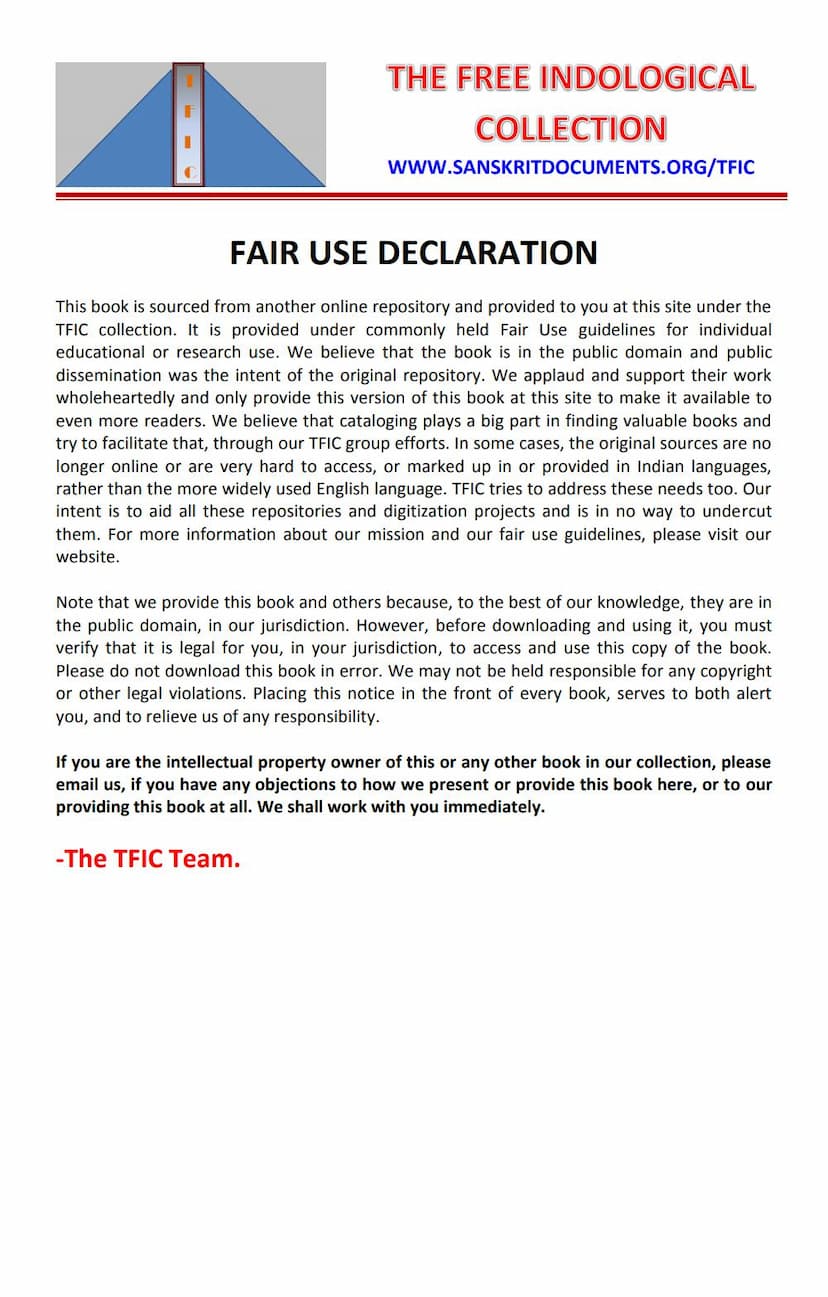Jainism Precepts And Practice
Added to library: September 2, 2025

Summary
Here's a comprehensive summary of the Jain text "Jainism: Precepts and Practice" by Puranchand Nahar and Krishnachand Ghosh, based on the provided table of contents and preface:
Overall Purpose and Approach:
"Jainism: Precepts and Practice" aims to provide a thorough and systematic exposition of Jainism, drawing from ancient and authoritative Jain texts. The authors present it not as a replacement for existing works but as a compilation that synthesizes the core principles, doctrines, and tenets of Jainism from a consistent Jain perspective. The book seeks to harmonize what might appear as disparate elements in traditional Jain literature, making them accessible and relevant in the modern context. The authors emphasize that their aim is to interpret and present the "spirit" of Jainism, even as forms may change.
Key Themes and Content:
The book delves into various aspects of Jainism, covering its philosophy, ethics, and historical context. Here's a breakdown of the major themes:
-
Epistemology and Logic: The work begins by establishing Jain epistemology as crucial for understanding its metaphysics. It highlights the Jain approach to knowledge, its forms, and the principles of "Syadvada" (the doctrine of conditioned predication) and "Anekantavada" (the doctrine of manifold aspects). The authors argue that the dialectical method, often attributed to Western philosophers like Hegel, has its origins in ancient Jain sages. They critically examine the limitations of other schools of thought, particularly the Charvaka's purely materialistic epistemology, and defend the Jain approach to valid knowledge (Pramana). The concept of "Nayavada" (the theory of perspectives) and the "Saptabhangi" (the sevenfold prediction) are explained as tools for understanding reality.
-
Metaphysics and Cosmology: The book explores Jain metaphysical categories, including "Dravya" (substance), "Guna" (quality), and "Paryaya" (modality). It defines "Jiva" (soul) and "Ajiva" (non-soul) as the fundamental constituents of the universe and discusses their nature, correlation, and the soul's constitutional freedom and divinity. The Jain view on causation is presented as a permutation and combination of fundamental rudiments like time, space, soul, and matter. They reject the need for an external creator God, attributing the diversity of the universe to the intrinsic powers and interactions of these rudiments.
-
Theories of Evolution and Creation: The text engages with theories of evolution and creation, contrasting them with the Jain perspective. It critiques scientific and philosophical theories of evolution and creation by external agencies, arguing that the universe's self-existence and permanence are key Jain tenets.
-
The Concept of God (or the God-head): Jainism, according to the authors, does not posit an extra-mundane, anthropomorphic God. Instead, the "God-head" is understood as the ultimate spiritual principle, the coalescence of pure, free, omniscient, and blissful souls who have attained "Nirvana" through the dissipation of karma. This spiritual essence is seen as present in all beings, giving substance and meaning to existence.
-
The Soul (Jiva): The nature of the soul is a central theme. Jainism views the soul as intrinsically free and potentially divine, trapped by "Karma." The book debunks materialistic conceptions of the soul, arguing that consciousness is not merely a byproduct of matter. It explains the Jain understanding of the soul as composed of "Pradeshas" (soul-units) and its inherent spiritual essence.
-
Karma and Rebirth: The concept of Karma is explored extensively, detailing its "phenomenology." The authors explain how the soul becomes entangled in the cycle of "Samsara" (the cycle of birth, death, and rebirth) through Karma. They discuss the transmigration of the "Karma-Sarira" (the body of karma) and its role in shaping future lives. The text also addresses critiques of the Karma doctrine, particularly from a Christian perspective, and defends Jain ethics and the principle of individual responsibility. The book argues that heredity alone cannot explain individual differences, pointing to Karma as the underlying cause.
-
Ethics and Practice: The book transitions from metaphysics to ethics, outlining the Jain path to liberation. It discusses "Right Vision," "Right Knowledge," and "Right Conduct" as the means to attain the ultimate goal. Key ethical concepts like "Influx" (Asrava) of karmic matter and "Bondage" (Bandha) due to delusion ("Mithyatva") are explained, along with the methods for overcoming them: "Samvara" (stopping the influx) and "Nirjara" (dissipation of karma). The stages of spiritual progress ("Gunasthanas") are also mentioned.
-
Historical and Comparative Aspects: The text touches upon the historical context of Jainism, mentioning the Tirthankaras as historical figures and the distinction between the Svetambara and Digambara traditions. It also draws comparisons with other Indian philosophical schools (Sankhya, Vedanta, Nyaya, Charvaka) and briefly engages with Western philosophical concepts and scientific theories.
Key Jain Concepts Explained:
- Syadvada: The doctrine of manifold perspectives and conditional predication, allowing for statements to be true from certain viewpoints but not absolutely.
- Anekantavada: The principle that reality has multiple aspects, and no single viewpoint can capture its entirety.
- Nayavada: The theory of perspectives that guides the understanding of different facets of reality.
- Saptabhangi: The sevenfold mode of predication derived from Syadvada, used to analyze reality from multiple angles.
- Dravya, Guna, Paryaya: The fundamental categories of substance, quality, and modality.
- Jiva and Ajiva: Soul and non-soul, the two fundamental substances.
- Karma: Action, and the subtle matter that accrues to the soul due to its actions, influencing its rebirths.
- Samsara: The cycle of birth, death, and rebirth.
- Nirvana/Moksha: Liberation from the cycle of Samsara, the ultimate goal of Jain practice.
- Tirthankaras: The spiritual teachers who establish the Jain order or "tirtha."
- Pradeshas: Soul-units or minute parts of the soul.
- Karma-Sarira: The subtle body composed of karma-matter that accompanies the soul through rebirths.
Overall Contribution:
"Jainism: Precepts and Practice" endeavors to present Jainism as a comprehensive, logical, and psychologically profound system of thought and practice. It aims to bridge the gap between ancient teachings and contemporary understanding, offering a coherent framework for studying and appreciating the richness of Jain philosophy and its ethical guidance for life.